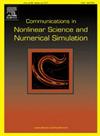分数阶耦合神经网络分布式有限时间同步的进一步结果
IF 3.4
2区 数学
Q1 MATHEMATICS, APPLIED
Communications in Nonlinear Science and Numerical Simulation
Pub Date : 2025-04-15
DOI:10.1016/j.cnsns.2025.108832
引用次数: 0
摘要
由于牛顿-莱布尼茨公式和链式法则不适用于分数阶微积分,整阶系统的有限时间同步的结果很难直接推广到分数阶系统。鉴于此,本文采用一种改进的方法研究分数阶耦合神经网络的有限时间同步问题。首先,利用拉普拉斯变换、Mittag-Leffler函数性质和反证法,建立了一个更广义的有限时间收敛的分数阶非线性微分不等式。此外,该不等式进一步推广了以往关于分数阶系统有限时间稳定性或同步的一些结果,为研究分数阶系统提供了一个新的工具。在此框架下,介绍了两种分布式有限时间控制方案:(1)基于全局信息的基本分布式有限时间控制方案;(2)一种改进的分数阶自适应分布式有限时间控制方案,避免了部分全局信息的依赖。然后,通过将同步状态作为考虑网络中的第(N+1)个节点来扩展通信拓扑,从而消除了对原始网络拓扑连通性的限制。最后,为了验证所提方法的可行性,给出了分数阶蔡氏电路系统的数值算例。本文章由计算机程序翻译,如有差异,请以英文原文为准。
Further results on distributed finite-time synchronization for fractional-order coupled neural networks
Given that the Newton-Leibniz formula and chain rule are not applicable to fractional calculus, the results of finite-time synchronization for integer-order systems are difficult to directly extend to fractional-order ones. In view of this, this paper is devoted to the finite-time synchronization for fractional-order coupled neural networks via a developed approach. Firstly, with the help of Laplace transform, the properties of Mittag-Leffler function and proof by contradiction, a more generalized fractional-order nonlinear differential inequality involved with finite-time convergence is established. Besides, some previous results on finite-time stability or synchronization of fractional-order systems can be further extended by this inequality, which presents a new tool for research. Under this framework, two distributed finite-time control schemes are introduced, (1) a basic distributed finite-time control scheme relying on some global information; (2) an improved fractional-order adaptive distributed finite-time control scheme, which avoids the dependence of some global information. Then, the communication topology is extended by including the synchronized state as a th node in the considered networks, which eliminates the restriction on original network topology connectivity. In the end, in order to verify the feasibility of the proposed method, a numerical example of fractional-order Chua’s circuit system is provided.
求助全文
通过发布文献求助,成功后即可免费获取论文全文。
去求助
来源期刊

Communications in Nonlinear Science and Numerical Simulation
MATHEMATICS, APPLIED-MATHEMATICS, INTERDISCIPLINARY APPLICATIONS
CiteScore
6.80
自引率
7.70%
发文量
378
审稿时长
78 days
期刊介绍:
The journal publishes original research findings on experimental observation, mathematical modeling, theoretical analysis and numerical simulation, for more accurate description, better prediction or novel application, of nonlinear phenomena in science and engineering. It offers a venue for researchers to make rapid exchange of ideas and techniques in nonlinear science and complexity.
The submission of manuscripts with cross-disciplinary approaches in nonlinear science and complexity is particularly encouraged.
Topics of interest:
Nonlinear differential or delay equations, Lie group analysis and asymptotic methods, Discontinuous systems, Fractals, Fractional calculus and dynamics, Nonlinear effects in quantum mechanics, Nonlinear stochastic processes, Experimental nonlinear science, Time-series and signal analysis, Computational methods and simulations in nonlinear science and engineering, Control of dynamical systems, Synchronization, Lyapunov analysis, High-dimensional chaos and turbulence, Chaos in Hamiltonian systems, Integrable systems and solitons, Collective behavior in many-body systems, Biological physics and networks, Nonlinear mechanical systems, Complex systems and complexity.
No length limitation for contributions is set, but only concisely written manuscripts are published. Brief papers are published on the basis of Rapid Communications. Discussions of previously published papers are welcome.
 求助内容:
求助内容: 应助结果提醒方式:
应助结果提醒方式:


